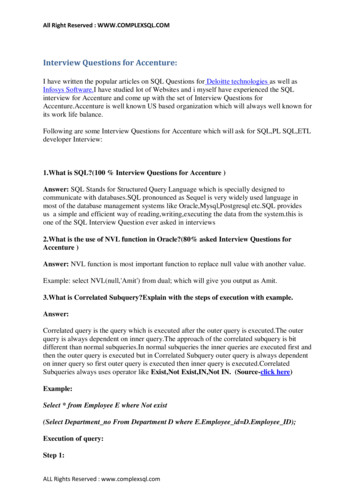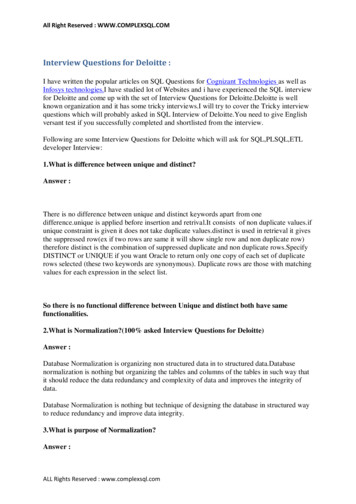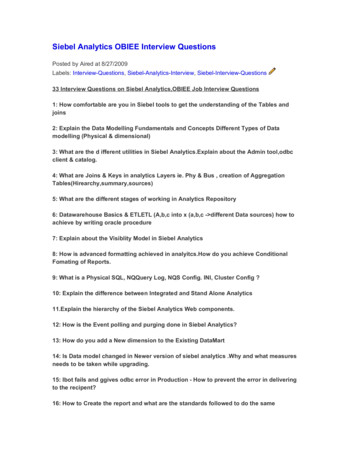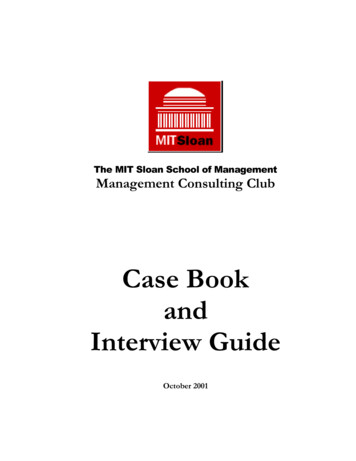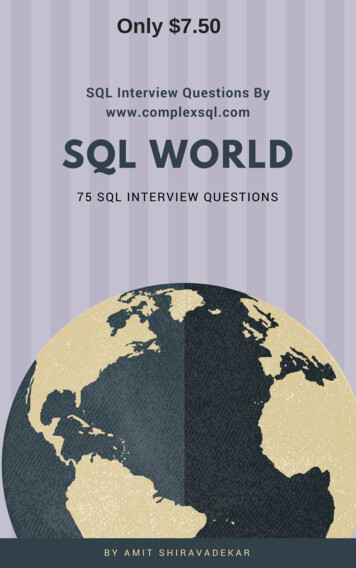
Transcription
Only 7.50SQL Interview Questions Bywww.complexsql.comSQL WORLD75 SQL INTERVIEW QUESTIONSBY AMIT SHIRAVADEKAR
Contents20 Basic SQL Interview Questions1-730 Most Important Complex SQLQuery Interview Questions8-1315 Interview Questions withAdvanced SQL13-2210 Interview Questions with PL SQL22-28
20 BASIC SQL INTERVIEW QUESTIONS1.What is SQL?Answer:SQL Stands for Structured Query Language which isspecially designed to communicate with databasespronounced as Sequel is very widely used language inmost of the database management systems like Oracle,MySQL, PostgreSQL etc.SQL provides us a simple andefficient way of reading,writing,executing the data fromthe system. This is one of the SQL Interview Questionever asked in interviews2.What is the use of NVL function in Oracle?Answer:NVL function is most important function to replace nullvalue with another value.Example: select NVL (null, 'Amit') from dual;which will give you output as Amit.3.What is Unique Key?Answer:Unique key is nothing but the columns which areuniquely identifies the values. There are more than oneunique keys for each table. The Entry of Null value isallowed in Unique key. Oracle does not permit you tocreate primary key and unique key on same column.Syntax:Create table Table name(Column name1 Datatype[null/not null],Column name Datatype[null/not null].Constraint constraint name Unique(uc col1,uc col2.))1
4.What is difference between Unique Key Constraintand Primary Key Constraint?Answer:Primary Key constraint:1.Primary key will not accept the null values in the tablecolumn.2.Primary is basically used to identify the unique records inthe table.3.We have only one primary key per table.Unique Key Constraint:1.Unique key accepts the null values in the table.2.The main task of unique key is it is used to removeduplicate values from the table with exception of null entry.3.We will have more than 1 unique keys on a single table.5.What is difference between varchar and varchar2datatype?Answer:Varchar can store up to 2000 bytes and varchar2 can storeup to 4000 bytes of memory space. Varchar will occupythe space for null values whereas varchar2 cannot occupythe space for null values. So varchar2 is good to use not toface performance related problems.varchar2 is faster thanvarchar datatype.6.How to represent comments in oracle?Answer:There are following 2 ways for commenting in oracle:1.Single Line comment: Two dashes (–) before beginningof the line2.Multiline comment/Block comment: When user wantsto comment multiple line /* */ operators are used.2
7.What is raw datatype?Answer:Raw datatype is used to store values in binary data format.There are 2 types of RAW datatype.1.Raw2.Long Raw.Long raw datatype is used to store graphics, sound documents.Raw datatype is variable length datatype like varchar2 butbasically it only stores data in 1 ‘s and 0’s means binary dataformat.8.What is ROWID & ROWNUM?Answer:ROWID is nothing but the physical address given to that rowwhich is in hexadecimal format. ROWNUM is nothing but thelogical sequence given to the row of that column.9.What are views in SQL? Explain types of Views in SQLAnswer:Views:Views are nothing but the logical structure of the table where wecan fetch the data from different tables or same table.There are 2 types of views in Oracle:1.Simple View: Simple view has been created on only a singletable.2.Complex view: Views which are created using more than 1table which has joins clauses are known as complex views.10.What is Materialized View in SQL?Answer:Materialized view is also logical structure of one or more table inwhich data is stored physically in the view. Data has beenstored physically in materialized view so data retrieval is fasteras compare to simple view.3
11.Why to use SQL?Answer:SQL is structured query language which is used formanipulation of data.There are following reasons why to use SQL: Allows users to access data in relational databasemanagement systems. Allows users to define the data in database andmanipulate that data. Allows users to create and drop databases and tables. Allows users to create view, stored procedure, functionsin a database. Allows users to set permissions on tables, procedures,and views.12.What is difference between Truncate, Drop andDELETE?Answer:1.Drop:1.Drop command is DDL command which is used to deletethe object from the database.2.We cannot use the “ROLLBACK” after using dropcommand.3.Drop command frees the space of database object.4.Drop table table name;2.Truncate:1.Truncate command is DDL command which is used totruncate the data from the database table.2.We cannot use the “ROLLBACK” after using Truncatecommand.3.It frees the space of database object but the structureremains same and memory of structure also remains same.4.Truncate table table name;4
3.Delete:1.Delete command is DML command which is used to deletethe records from table.2.We can use Rollback to Rollback the records from the table.3.Delete command not frees the memory space.4.Delete table table name where condition;13.Explain About DDL Statements of SQL?AnswerDDL – DDL stands for Data Definition Language:Statement DescriptionCREATE Creates a new table, a view of a table, or other objectin databaseALTER Modifies an existing database object, such as a table.DROP Deletes an entire table, a view of a table or other objectin the database.14.What is DML in SQL. Explain DML Statements inDetails?Answer:DML stands for Data Manipulation Language:Statement DescriptionINSERT Creates a recordUPDATE Modifies recordsDELETE Deletes records15.What is Database?Answer: It is a collection of Inter-Related data. Records the data inHDD (Permanent Memory). Inter-Related data means relation among data values Objective of DB is to record data & save it for future use.5
16.What is RDBMS?Answer:RDBMS stands for Relational DataBase Management System.RDBMS is the basis for SQL, and for all modern database systemslike MS SQL Server, IBM DB2, Oracle, MySQL, and MicrosoftAccess.A Relational database management system (RDBMS) is adatabase management system (DBMS) that is based on therelational model as introduced by E. F. Codd.17. What are tables and Fields?Answer:A table is set of data which is organized in to specific structuredmanner. Table is made up of combination of columns and rows. Atable has specified number of column called fields but can haveany number of rows which is called record.Example: TableName(Field 1) Salary(Field 2)Amit S(Record1) 10000(Record1)18.Explain me about SQL joins?Answer:Join is nothing but connecting 2 tables to fetch the records from 2or more different tables.There are following types of joins in SQL:1.Inner join:Inner join retrieves the records which are common between 2 ormore tables.2.Outer join:Outer join retrieves the common records from the table as well asuncommon records from Left or right table.2.1. Left outer join:When user needs to fetch all data from left table and commonrecords from left and right table then the join is called as left outerjoin.6
2.2. Right outer join:When user needs to fetch all data from right table and commonrecords from left and right table then the join is called as rightouter join.2.3. Full Outer Join:When user needs to fetch the data from both the tables andcommon records from both of the tables.3.Cross join/Cartesian join:When each record is connected to each and every record fromother table then it is called as cross join or Cartesian join.19.What is Views in SQLAnswer:View is nothing but the virtual structure which is been createdfrom using single table or multiple tables. If the logical structureis created from single table then it is called as Simple view. Iflogical structure is created using multiple tables using joinsthen it is called as Complex View.20.What is index and what are types of indexes?Answer:Indexing is nothing but the performance tuning mechanismwhich allows the fast retrieval of the records from table.Following are types of indexes:1.Normal Indexes2.Bit Map indexes3.Unique indexes4.Clustered Indexes5.NonClustered Indexest7
30 Complex SQL Queries1.Query to find Second Highest Salary of Employee?Answer:Select distinct Salary from Employee e1 where 2 Selectcount(distinct Salary) from Employee e2 wheree1.salary e2.salary;Alternative Solution :select min(salary)from(select distinct salary from emp order bysalary desc)where rownum 2;2.Query to find duplicate rows in table?Answer :Select * from Employee a where rowid ( select max(rowid) fromEmployee b where a.Employee num b.Employee num);3.How to fetch monthly Salary of Employee if annual salary isgiven?Answer:Select Employee name,Salary/12 as ‘Monthly Salary’ fromemployee;4.What is the Query to fetch first record from Employeetable?Answer:Select * from Employee where Rownum 1;Click here to get What is Rownum?5.What is the Query to fetch last record from the table?Answer:Select * from Employee where Rowid select max(Rowid) fromEmployee;8
6.What is Query to display first 5 Records fromEmployee table?Answer:Select * from Employee where Rownum 5;7.What is Query to display last 5 Records fromEmployee table?Answer:Select * from Employee e where rownum 5unionselect * from (Select * from Employee e order by rowid desc)where rownum 5;8.What is Query to display Nth Record from Employeetable?Answer :select * from ( select a.*, rownum rnum from (YOUR QUERY GOES HERE — including the order by ) awhere rownum N ROWS ) where rnum N ROWS9.How to get 3 Highest salaries records from Employeetable?Answer:select distinct salary from employee a where 3 (selectcount(distinct salary) from employee b where a.salary b.salary) order by a.salary desc;Alternative Solution:select min(salary)from(select distinct salary from emp orderby salary desc)where rownum 3;10.How to Display Odd rows in Employee table?(Answer:Select * from(Select rownum as rno,E.* from Employee E)where Mod(rno,2) 1;9
11.How to Display Even rows in Employee table?Answer:Select * from(Select rownum as rno,E.* from Employee)where Mod(rno,2) 0;12.How to fetch 3rd highest salary using RankFunction?Answer:select * from (Select Dense Rank() over ( order by salarydesc) as Rnk,E.* from Employee E) where Rnk 3;13.How Can i create table with same structure ofEmployee table?Answer:Create table Employee 1 as Select * from Employee where1 2;14.Display first 50% records from Employee table?Answer:select rownum, e.* from emp e where rownum (selectcount(*)/2 from emp);15.Display last 50% records from Employee table?Answer:Select rownum,E.* from Employee EminusSelect rownum,E.* from Employee E where rownum (Select count(*)/2) from Employee);16.How Can i create table with same structure with dataof Employee table?Answer:Create table Employee1 as select * from Employee;10
17.How do i fetch only common records between 2 tables.Answer:Select * from Employee;IntersectSelect * from Employee1;18.Find Query to get information of Employee whereEmployee is not assigned to the departmentAnswer:Select * from Employee where Dept no Not in(SelectDepartment no from Employee);19.How to get distinct records from the table withoutusing distinct keyword.Answer:select * from Employee a where rowid (select max(rowid)from Employee b where a.Employee no b.Employee no);20.Select all records from Employee table whose name is‘Amit’ and ‘Pradnya’Answer:Select * from Employee where Name in(‘Amit’,’Pradnya’);21.Select all records from Employee table where name notin ‘Amit’ and ‘Pradnya’Answer:select * from Employee where name Not in (‘Amit’,’Pradnya’);22.How to fetch all the records from Employee whosejoining year is 2017?Answer:Oracle:select * from Employee whereTo char(Joining date,’YYYY’) ’2017′;11
23.What is SQL Query to find maximum salary of eachdepartment?Answer:Select Dept id,max(salary) from Employee group by Dept id;24.How Do you find all Employees with its managers?(Consider there is manager id also in Employee table)Answer:Select e.employee name,m.employee name from Employeee,Employee m where e.Employee id m.Manager id;25.Display the name of employees who have joined in2016 and salary is greater than 10000?Answer:Select name from Employee where Hire Date like ‘2016%’and salary 10000;26.How to display following using query?******Answer:We cannot use dual table to display output given above. Todisplay output use any table. I am using Student table.SELECT lpad (‘*’, ROWNUM,’*’) FROM Student WHEREROWNUM 4;27.How to add the email validation using only one query?Answer :SELECTEmailFROMEmployeewhere NOT REGEXP LIKE(Email, ‘[A-Z0-9. % -] @[A-Z09.-] \.[A-Z]{2,4}’, ‘i’);12
28.How to display 1 to 100 Numbers with query?Answer:Select level from dual connect by level 100;29.How to remove duplicate rows from table?Answer:First Step: Selecting Duplicate rows from tableSelect rollno FROM Student WHERE ROWID (Select max (rowid) from Student b where rollno b.rollno);Step 2:Delete duplicate rowsDelete FROM Student WHERE ROWID (Select max (rowid) from Student b where rollno b.rollno);30.How to find count of duplicate rows?Answer:Select rollno, count (rollno) from StudentGroup by rollnoHaving count (rollno) 1Order by count (rollno) desc;13
15 Interview Questions withAdvanced SQL1.What is the latest version of Oracle?Answer :Oracle has announced the new version which will come indecember 2017 which is Oracle 18c. Oracle 18c is worldsfirst autonomous database.2.What are advantages of Oracle 18c?Answer :Oracle CTO has announced that new database version ofOracle will come till December 2017 which is Oracle18c.Oracle 18c is worlds first autonomous database whichwill do lot of tasks will be automated using ArtificialIntelligence Engine.Following are some advantages of Oracle 18c :1. Oracle 18c uses adaptive machine learning which willreduce the human errors.2. It reduces the complexity of database3. It is highly relible and secure database4. It reduces the operational cost5. Self Driving database6. Self Tuning database7. Most efficient consumption of resources8. Less human intervention14
3.What are different database Environments used in anyproject?Answer:The Project to project database environment varies.But thefollowing is basic environment structure used for projects.1.Development Environment:In Development Environment all developer works anddevelopment work is been done on development environment.2.Test Environment:Developers does not have access of test environment.Afterdevelopment is done the code is migrated to TestEnvironment.Testing team is working on Test environment andexecute black box as well as white box test cases on thisEnvironment.Sometimes System Integration Testing (SIT) isalso done on this Environment.3.UAT Environment:UAT stands for User Acceptance Testing.On this Environmentthe Customer side testers tests the software and executesUser Acceptance Test Cases.4.Performance Testing Environment:On this environment the performance tester tests allperformance related issues on this environment. Thisenvironment contains very huge data and performance testerwill try to break the system using that big data.5.Production Environment:On this Environment actual user works and uses the software15.
4.What is mean by Sequence in database?Answer:Use the CREATE SEQUENCE statement to create asequence, which is a database object from which multipleusers may generate unique integers. You can usesequences to automatically generate primary key values.When a sequence number is generated, the sequence isincremented, independent of the transaction committing orrolling back.Once a sequence is created, you can access its values inSQL statements with the CURRVAL Pseudo Column,which returns the current value of the sequence, or theNEXTVAL Pseudo Column, which increments thesequence and returns the new value.5.What are 3 different imporatant features of Oracle18c?Answer :1. Self Driving Database :1.1. Oracle 18 c is self driving database in whichpatching,upgrades and backups can be doneautomatically.1.2.No delay waiting for human process and downtime.1.3.Automated treat detection and remediation.1.4. All database maintenance tasks will be done withouthuman interventions.16
2. Reliable :2.1. It is very reliable database as it has self recoveringcapability of detecting and applying corrective actions.2.2.Oracle Autonomous Database Cloud automaticallyimplements Oracle Real Application Cluster(RAC).2.3.No downtime required for upgrades,patching or addingstorage capacity.3.Lower Cost :3.1.It eliminates the costly downtime3.2.Self Tuning uses adaptive machine learning whichautomatically activates caching,indexing,storage ofindexes.3.3.It avoids costly overprovisioning.3.4. It also helps to cut the labour cost as Oracle 12c isautomated self driving database.3.5. Oracle 18c is 5x to 13x less expensive than AWS(Amazon Web Services).6.What are functions of Parser?Answer:1.Syntax Analysis:The parser checks for SQL statement syntaxs.If the syntaxis incorrect then parser gives the incorrect syntax error.2.Semantic Analysis:This checks for references of object and object attributesreferenced are correct.17
7.What is Null in SQL?Answer:A NULL value in a table is a value in a field that appears tobe blank, which means a field with a NULL value is a fieldwith no value.It is very important to understand that a NULL value isdifferent than a zero value or a field that contains spaces. Afield with a NULL value is one that has been left blank duringrecord creation.8. What is not null constraint?Answer:By default, a table column can hold NULL values. The NOTNULL constraint enforces a column to NOT accept NULLvalues.The NOT NULL constraint enforces a field to always containa value. This means that you cannot insert a new record, orupdate a record without adding a value to this field.9.How to find all details about Constraint?Answer:1.Select * from User constraints;or2.Select * from User cons columns;18
10.What is Query to display last 5 Records fromEmployee table?Answer:Select * from Employee e where rownum 5unionselect * from (Select * from Employee e order by rowiddesc) where rownum 5;11.What is Correlated Subquery?Explain with thesteps of execution with example.Answer:Correlated query is the query which is executed afterthe outer query is executed.The outer query is alwaysdependent on inner query.The approach of thecorrelated subquery is bit different than normalsubqueries.In normal subqueries the inner queries areexecuted first and then the outer query is executed butin Correlated Subquery outer query is alwaysdependent on inner query so first outer query isexecuted then inner query is executed.CorrelatedSubqueries always uses operator like Exist,NotExist,IN,Not IN. (Source-click here)Example:Select * from Employee E where Not exist(Select Department no From Department D whereE.Employee id D.Employee ID);19
Execution of query:Step 1:Select * from Employee E ;It will fetch the all employeesStep 2:The First Record of the Employee second query is executedand output is given to first query.(Select Department no From Department D whereE.Employee id D.Employee ID);Step 3:Step 2 is repeated until and unless all output is beenfetched.12.What is raw datatype?Answer:Raw datatype is used to store values in binary data format.There are 2 types of RAW datatype:1.Raw2.Long Raw.Long raw datatype is used to store graphics,sounddocuments.Raw datatype is variable length datatype like varchar2 butbasically it only stores data in 1 ‘s and 0’s means binarydata format.
13.What is materialised view and what are its differentfields while creating it?Answer :Materialized view is also logical structure of one or moretable in which data is stored physically in the view.Data hasbeen stored physically in materialized view so data retrievalis faster as compare to simple view.There are following different options we used to creatematerialized view or snapshot.1.Build Immediate:Means materialized views(mv) created immediately.2.Build Deferred:Means materialized views(mv) created after one refresh.3.Refresh on commit:This option commited the data in materialized view in SQLimmediately after data inserted and committed in table.Thisoption is known as incremental refresh option.View is notfully refreshed with this option4.Refresh on Demand:Using this option you can add the condition for refreshingdata in materialized views.21
14.What is first and last function in SQL?Answer:The FIRST and LAST functions can be used to return thefirst or last value from an ordered sequence. Say we want todisplay the salary of each Employee, along with the lowestand highest within their department we may use somethinglike.Example:SELECT EmpNo, DeptNo, Sal ,MIN (Sal) KEEP(DENSE RANK FIRST ORDER BY Sal) OVER (PARTITIONBY DeptNo)”Lowest”, MAX (Sal) KEEP (DENSE RANKLAST ORDER BY Sal) OVER (PARTITION BY DeptNo)“Highest”FROM EMPLOYEE ORDER BY DeptNo, Sal;15.What is a transaction? What are ACID properties?Answer:A Database Transaction is a set of database operations thatmust be treated as whole, means either all operations areexecuted or none of them.An example can be bank transaction from one account toanother account. Either both debit and credit operationsmust be executed or none of them.ACID (Atomicity, Consistency, Isolation, Durability) is a set ofproperties that guarantee that database transactions areprocessed reliably.22
10 Interview Questions with PL SQL1.What is cursor in PL SQL ?Answer :Cursor is a buffer area which is used to process multiplerecords and also record by record tabs.There are 2 types of cursors :1.Implicit cursor2.Explicit cursorImplicit cursor : Implicit cursor is a buffer area which has beendefined and controlled by oracle internally. Implicit cursor willprocess single record at a time.example :declarev Ename varchar2(100);beginselect ename into V Ename from Employee whereempno 101;dbms output.put line(V Ename );end;The above cursor is implicit cursor where all the operationsare defined by oracle engine internally like declaring thecursor,fetching values from the cursor and close cursor.Explicit Cursor : Explicit cursor is a cursor which is defined byuser to process set of records.For multiple records user needsto use explicit cursor.Explicit cursor operations are done bythe user.There are following 4 operations needs to be done by user :1.Declare cursor2.Open cursor3.Fetch all records from the cursor4.Close cursor.23
2.What are different cursor attributes?Answer :There are following cursor attributes :1.%Found2.%Not Found3.%Isopen4.%Rowcount3.What is ref cursor?Why it is used?Answer :As the name suggested ref cursor is a variable which willpoint to the address or reference of the cursor.Ref cursor isvariable not cursor but that variable points to cursor.There are 2 type of ref cursors :1.Strong Ref cursor2.Weak Ref cursor4.How to write Cursor with for loop?Answer:Cursor declares %ROWTYPE as loop index implicitly. It thenopens a cursor, gets rows of values from the active set infields of the record and shuts when all records areprocessed.Means while using the for loop user dont need toOpen the cursor and fetch the values from cursor or closecursor explicitly.In For loop all cursor operations done implicitly.24
Real Example:FOR Sample cursor IN C1 LOOPTotal Salary Total Salary Appraisals;END LOOP;5.What is Database Trigger?What is real use oftrigger?Answer :PL SQL procedure which is used to trigger specific eventon specific condition is known as database triggers.Triggers are database objects with specific conditions.Examples of Trigger :1)Audit data modifications.2)Log events transparently.3)Enforce complex business rules.4)Maintain replica tables5)Derive column values6)Implement Complex security authorizations.25
6.What is %ROWTYPE ? Explain this with example.Answer :%ROWTYPE is cursor attribute which is used to define therecord of the field.Each field assumes it own datatype and%ROWTYPE is used to define the specific record type.example :CREATE OR REPLACE PROCEDUREP Employee InformationISCURSOR Emp Cur IS SELECT Employee name,Employee Number FROM emp;variable1 Emp Cur %ROWTYPE; ---This is cursor variablenameBEGINOPEN Emp Cur ;LOOPFETCH Emp Cur INTO variable1;EXIT WHEN Emp Cur %Notfound; ---When cursorDBMS OUTPUT.PUT LINE( variable1.Employee name 'works in department ' myvar.Employee Number);END LOOP;CLOSE Emp Cur ;END;26
7.What is Raise Application Error?Answer :When user wants to insert Error message then user needs touse the Raise Application Error procedure.Raise Application Error is the system defined procedure ofpackage named DBMS STANDARD.Syntax :Raise Application Error(Error Code,Error Message);Example :Raise Application Error (-20343, ‘The balance is too low.’);8.What is commit?RollBack?Savepoint?Answer :Commit :When user commits the data after transaction that changesare permanent changes.1.Other users can see the data changes made by thetransaction.2.The locks acquired by the transaction are released.3.The work done by the transaction becomes permanent.Rollback :When transaction become wrong user can rollback the data.1.The work done in a transition is undone as if it was neverissued.27
2.All locks acquired by transaction are released.Savepoint :It undoes all the work done by the user in a transaction.With SAVEPOINT, only part of transaction can beundone.9.What is mutating error?Answer :It occurs when a trigger tries to update a row that it iscurrently using. It is fixed by using views or temporarytables, so database selects one and updates the other.10.What is difference between Anonymous blockand subprogram?Answer :Anonymous block :Anonymous blocks are programs or unnamed blockwhich is used to check some functionality and which arenot stored in database.Subprograms :Subprograms are stored blocks which are stored in todatabase. Subprograms are compiled at runtimeFor More Interview Questions Visit:www.complexsql.com.28
RDBMS is the basis for SQL, and for all modern database systems like MS SQL Server, IBM DB2, Oracle, MySQL, and Microsoft Access. A Relational database management system (RDBMS) is a database management system (DBMS) that is based on the relational model as introduced by E. F. Codd. 1 7 . W
